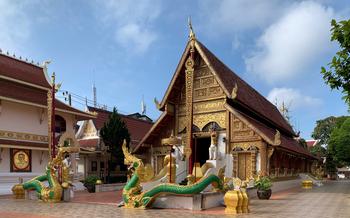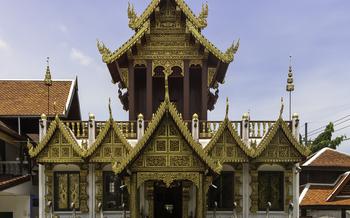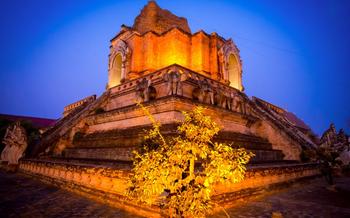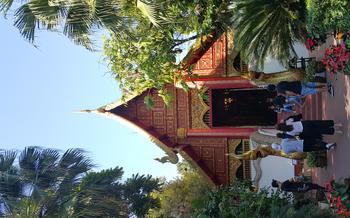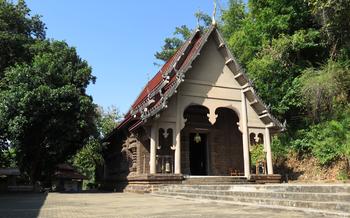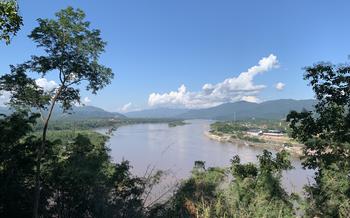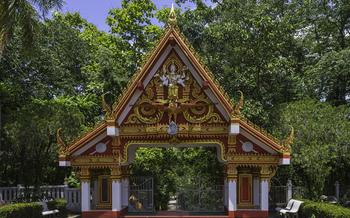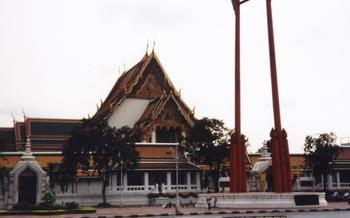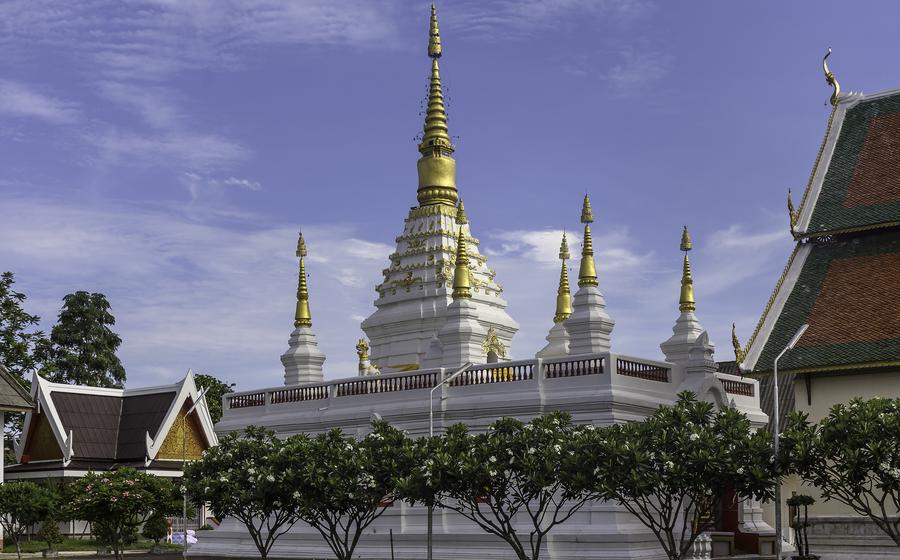
Wat Chetawan
- Wat Chetawan: A Buddhist Temple with a Unique Architectural Design
- Marvel at the Grand Stupa
- Explore the Buddha Image at the Temple's Center
- Iconography and Symbolism of the Buddha Statue
- Materials Used and Construction Techniques
- History and Origin of the Buddha Image
- Rituals and Offerings Made to the Buddha Statue
- Discover the Ancient Buddha Images and Artifacts
- Uncover the Mythical Creatures and Deities
- Experience the Temple's Peaceful Ambiance
- Learn about the Temple's History and Cultural Significance
- Immerse Yourself in the Local Culture
- Tips for Respectful Interaction and Cultural Sensitivity:
- Attend a Meditation Session or Dharma Talk
- Explore the Surrounding Area
- Take Stunning Photographs
- Enjoy a Relaxing Retreat
- Support Local Artisans and Craftspeople
- Make a Meaningful Contribution
- Insider Tip: Hidden Gems and Secret Spots
Wat Chetawan: A Buddhist Temple with a Unique Architectural Design
Wat Chetawan stands out among Chiang Rai's many temples due to its distinctive architectural style, a harmonious blend of Lanna and Burmese influences. This striking temple was constructed in the early 20th century by a wealthy teak merchant named Chao Chet Ton. The intricate details and grandeur of its design reflect the merchant's devotion and the significance of the temple in the local community.
The temple's most captivating feature is the seven-headed Naga staircase, a symbol of protection and prosperity in Buddhist mythology. The majestic serpent deities, adorned with colorful scales and fierce expressions, guard the entrance to the temple, creating an awe-inspiring welcome for visitors.
The temple's architecture showcases intricate carvings, delicate stucco work, and gleaming golden stupas that shimmer in the sunlight. The combination of these elements creates a visually stunning and spiritually uplifting environment that invites visitors to explore the temple's many wonders.
Practical Information:
- Visiting Hours: Daily from 8:00 AM to 5:00 PM
- Dress Code: Visitors are expected to dress modestly, covering their shoulders and knees.
- Entrance Fee: Admission is free, but donations are welcome.
Marvel at the Grand Stupa
In the heart of Wat Chetawan, a majestic stupa, or chedi, rises as a symbol of Buddhist wisdom and enlightenment. This grand monument stands tall, reaching towards the heavens, and serves as a focal point for pilgrims and visitors alike. The stupa at Wat Chetawan is of great significance in Buddhism, representing the Buddha's teachings and the path to liberation. It is believed to enshrine relics, sacred objects associated with the Buddha or his disciples, adding to its spiritual importance.
The stupa's design and dimensions are awe-inspiring. Constructed with meticulous precision, it features a circular base that gradually tapers towards the top, culminating in a graceful spire. The exterior of the stupa is adorned with intricate carvings, delicate moldings, and gleaming gold leaf, reflecting the artistic prowess and devotion of the temple's builders.
Within the stupa, a hidden chamber houses relics of great religious significance. These may include fragments of bone, ashes, or personal belongings of the Buddha or his followers. The relics are believed to possess a powerful spiritual energy, capable of inspiring devotion, granting blessings, and bringing good fortune to those who pay homage to them.
Rituals and ceremonies are often performed at the stupa to honor the Buddha's teachings and seek blessings. Devotees circumambulate the stupa, offering prayers, flowers, and incense as a sign of respect and devotion. The gentle ringing of bells and the chanting of mantras fill the air, creating an atmosphere of serenity and spirituality.
Explore the Buddha Image at the Temple's Center
At the heart of Wat Chetawan, a colossal Buddha image commands attention with its serene presence. This awe-inspiring statue embodies the essence of the temple, radiating an aura of peace and tranquility. Standing tall and majestic, the Buddha exudes an otherworldly aura, inviting visitors to pause and contemplate its profound significance.
Iconography and Symbolism of the Buddha Statue
The Buddha image at Wat Chetawan is a masterpiece of Buddhist art, embodying the traditional iconography and symbolism associated with the enlightened being. The statue portrays Buddha in the classic seated posture, with his right hand raised in the Abhaya mudra, representing reassurance and protection. His left hand rests gently in the Dhyana mudra, symbolizing meditation and inner peace.
Materials Used and Construction Techniques
Crafted from pure white marble, the Buddha statue exudes an ethereal quality. The intricate details and delicate features of the sculpture showcase the exceptional artistry and craftsmanship that went into its creation. The marble's smooth surface reflects the soft glow of the temple's interior, further enhancing its serene and meditative atmosphere.
History and Origin of the Buddha Image
The origins of the Buddha image at Wat Chetawan are shrouded in mystery, adding to its allure. While its exact history remains unknown, it is believed to date back to the early 19th century, coinciding with the temple's construction. According to local legend, the statue was discovered by a group of monks during a meditation retreat in the surrounding forest. They recognized its sacred significance and brought it to the temple, where it has been revered ever since.
Rituals and Offerings Made to the Buddha Statue
Devotees from far and wide flock to Wat Chetawan to pay homage to the Buddha image. They offer prayers, light incense, and present flowers as tokens of respect and gratitude. The temple encourages visitors to participate in these rituals, providing insight into the Buddhist tradition of expressing devotion and seeking blessings.
Discover the Ancient Buddha Images and Artifacts
Wat Chetawan houses a remarkable collection of Buddha images and artifacts, offering a glimpse into the rich history and evolution of Buddhist art and culture. These Buddha images span from the early to late periods of Buddhist history, showcasing the transformation of iconography, styles, and materials used. Visitors can admire the serene features of bronze Buddha statues, marvel at the intricate carvings of sandstone and marble sculptures, and appreciate the gilded splendor of wooden Buddha images.
Some of the most significant Buddha images include a 13th-century bronze statue of the Buddha in the Subduing Mara posture, a 15th-century sandstone sculpture of the Buddha in the Earth Touching posture, and a 17th-century wooden statue of the Buddha in the Reclining posture. These statues are not only aesthetically captivating but also hold immense historical and cultural significance, representing different schools of Buddhism and the artistic influences of various periods.
Uncover the Mythical Creatures and Deities
Wat Chetawan is a treasure trove of mythical creatures and deities, each holding significant symbolic meaning in Buddhist mythology. Majestic Nagas, with their serpentine bodies and multiple heads, represent protection and wisdom. The Garudas, half-human, half-bird beings, symbolize spiritual elevation and victory over evil. Yakshas, powerful guardians of the temple, are often depicted with fierce expressions and weapons, while Devas, celestial beings, embody benevolence and compassion.
These mythical figures play crucial roles in Buddhist mythology, representing various aspects of the human experience and the journey towards enlightenment. Their artistic representations throughout the temple, in sculptures, murals, and architectural elements, add depth and richness to the overall spiritual ambiance.
Discover the stories and legends associated with these mythical creatures and deities, and gain insights into the intricate tapestry of Buddhist beliefs and folklore.
Experience the Temple's Peaceful Ambiance
Wat Chetawan exudes a palpable sense of tranquility, inviting visitors to immerse themselves in its serene atmosphere. In Buddhism, peace and tranquility are considered essential for inner growth and spiritual development. The temple's tranquil surroundings provide the perfect setting for meditation, reflection, and mindfulness practices. Visitors can escape the hustle and bustle of everyday life and find a sanctuary of peace within the temple's sacred grounds. By embracing the temple's peaceful ambiance, visitors can cultivate a sense of inner calm, reduce stress, and enhance their overall well-being.
Tips for Creating a Mindful and Meditative Experience
-
Silence Your Phone: Create a distraction-free environment by turning off your phone and other electronic devices.
-
Deep Breathing: Practice mindful breathing exercises to center yourself and connect with the present moment.
-
Walk Slowly: Take a slow and meditative walk around the temple grounds, appreciating the beauty and serenity of your surroundings.
-
Engage Your Senses: Notice the sounds of birds chirping, the gentle breeze rustling through the leaves, and the fragrant aroma of incense.
-
Find a Quiet Spot: Seek out a secluded spot within the temple compound to sit in silence and simply be present.
Learn about the Temple's History and Cultural Significance
Wat Chetawan's history is deeply intertwined with the cultural and religious fabric of Chiang Rai. Founded in the 14th century, the temple has witnessed significant historical events and has played a pivotal role in preserving and promoting Buddhist traditions in the region.
The temple's origins can be traced back to a revered monk named Phra Kru Ba Srivichai, who dedicated his life to spreading Buddhism throughout northern Thailand. He chose the site of Wat Chetawan, which was then a dense forest, as a place for meditation and spiritual retreat. Over time, the temple grew in prominence, attracting devotees and pilgrims from near and far.
Throughout the centuries, Wat Chetawan has undergone several renovations and expansions. In the 19th century, the temple was largely destroyed by fire, but it was meticulously rebuilt and restored to its former glory. The current structures, including the grand stupa and the Buddha image, are relatively recent additions, dating back to the mid-20th century.
Wat Chetawan holds immense cultural and religious significance for the local community. It is considered a sacred pilgrimage site and is often visited by Thai people from all walks of life. The temple is also a center for Buddhist learning and education, with monks teaching meditation, Dharma, and Buddhist philosophy.
Immerse Yourself in the Local Culture
Wat Chetawan offers a unique opportunity to immerse yourself in the local culture and traditions of Chiang Rai. Engage with the friendly monks and learn about their daily lives, their beliefs, and the practices of Buddhism. Participate in cultural events and festivals held at the temple, such as merit-making ceremonies, chanting sessions, and traditional Thai dance performances. These events provide a glimpse into the rich cultural heritage of the region and allow you to connect with the local community on a deeper level.
Tips for Respectful Interaction and Cultural Sensitivity:
- Dress modestly and respectfully, covering your shoulders and knees.
- Remove your shoes before entering the temple's sacred spaces.
- Be mindful of your behavior and maintain a respectful demeanor.
- Ask permission before taking photographs of monks or other individuals.
- Avoid touching Buddha images or other religious objects.
- Offer a small donation or make a merit offering to support the temple.
- Observe local customs and traditions, such as the wai (a traditional Thai greeting) and the clockwise circumambulation of the stupa.
Attend a Meditation Session or Dharma Talk
Wat Chetawan offers a variety of meditation sessions and Dharma talks, providing visitors with an opportunity to deepen their understanding of Buddhism and cultivate inner peace. These sessions are typically led by experienced monks or teachers who guide participants through various meditation techniques and teachings.
Types of Meditation Offered: - Mindfulness Meditation: This practice involves focusing on the present moment and cultivating awareness of one's thoughts, feelings, and sensations without judgment. - Loving-Kindness Meditation: This meditation promotes compassion and loving-kindness towards oneself and others, helping to develop a sense of interconnectedness. - Vipassana Meditation: This insight meditation technique encourages participants to observe their thoughts and emotions with detachment, leading to a deeper understanding of the nature of reality.
Benefits of Meditation and Mindfulness Practices: - Stress Reduction: Meditation has been shown to effectively reduce stress and anxiety, promoting relaxation and inner peace. - Improved Focus and Concentration: Regular meditation practice can enhance focus and concentration, leading to greater productivity and clarity of mind. - Increased Self-Awareness: Meditation cultivates self-awareness, allowing individuals to gain a deeper understanding of their thoughts, emotions, and patterns of behavior. - Compassion and Empathy: Meditation practices can foster compassion and empathy towards oneself and others, promoting harmonious relationships and a sense of interconnectedness.
Schedule and Format: - Meditation sessions and Dharma talks are usually held daily at specific times. Visitors are advised to check the temple's schedule or inquire with the monks for more information. - Sessions typically begin with a brief introduction to the meditation technique or teaching, followed by a guided meditation practice. - Dharma talks often explore Buddhist teachings and philosophies, providing insights into the nature of reality, suffering, and the path to liberation.
Tips for Beginners: - No prior experience is necessary to attend a meditation session. - It's important to approach meditation with an open mind and a willingness to learn. - Beginners may find it helpful to start with shorter meditation sessions, gradually increasing the duration as they become more comfortable. - If thoughts or distractions arise during meditation, gently acknowledge them and return your attention to the present moment.
Guidance on Meditation Techniques: - For mindfulness meditation, focus on your breath or bodily sensations, observing them without judgment. - In loving-kindness meditation, extend feelings of love and compassion towards yourself and others, visualizing them as bathed in a warm, golden light. - For Vipassana meditation, observe your thoughts and emotions as they arise and pass away, without clinging or rejecting them.
By attending a meditation session or Dharma talk at Wat Chetawan, visitors can gain valuable insights into Buddhist teachings, cultivate inner peace, and embark on a journey of self-discovery.
Explore the Surrounding Area
Beyond the temple grounds, Chiang Rai offers a wealth of cultural and natural attractions that complement your visit to Wat Chetawan. Embark on a leisurely stroll through the city's vibrant markets, where you can immerse yourself in the sights, sounds, and aromas of local life. Discover traditional handicrafts, savor delicious street food, and interact with friendly vendors.
For a taste of history, explore the ancient ruins of Wiang Kum Kam, a former Lanna kingdom capital located just outside Chiang Rai. Wander among the remnants of old city walls, temples, and stupas, and let your imagination transport you back in time.
Nature enthusiasts will find solace in the stunning landscapes surrounding Chiang Rai. Take a day trip to the majestic Doi Mae Salong, the highest peak in the province, and enjoy panoramic views of the lush countryside. Hike through lush forests, encounter diverse wildlife, and visit hill tribe villages to learn about their unique cultures and traditions.
To fully embrace the local culture, attend one of the many festivals held throughout the year in Chiang Rai. From the vibrant Loi Krathong festival, where thousands of floating lanterns illuminate the night sky, to the colorful Flower Festival, which showcases the region's beautiful flora, these events offer a glimpse into the rich heritage of Northern Thailand.
Take Stunning Photographs
With its captivating architecture, intricate details, and serene atmosphere, Wat Chetawan is a dream come true for photographers. Capture the essence of this sacred site through your lens and share its beauty with the world.
Photogenic Spots Within the Temple Compound:
-
Grand Stupa: The towering stupa dominates the temple's skyline, offering breathtaking views from every angle. Capture its grandeur, intricate carvings, and golden stupas against the blue sky.
-
Seven-Headed Naga Staircase: This iconic staircase is a photographer's delight, with its majestic naga serpents guarding the entrance to the temple. Experiment with different angles and perspectives to capture their imposing presence.
-
Buddha Image at the Temple's Center: The serene Buddha statue exudes an aura of peace and tranquility. Photograph its intricate features, serene expression, and the delicate lotus pedestal on which it rests.
-
Ancient Buddha Images and Artifacts: Explore the collection of Buddha images and artifacts, each with its own unique story to tell. Capture the intricate details, varying styles, and the patina of time that adds character to these sacred objects.
-
Mythical Creatures and Deities: The temple is home to various mythical creatures and deities, each with symbolic meaning. Photograph their intricate representations, paying attention to their expressions, postures, and the stories they convey.
-
Peaceful Ambiance: Capture the essence of the temple's peaceful ambiance through your lens. Photograph the serene surroundings, the interplay of light and shadow, and the tranquil expressions of monks and visitors.
Tips for Capturing the Temple's Beauty and Unique Features:
-
Use Natural Light: The best time to photograph Wat Chetawan is during the golden hours of sunrise and sunset when the temple's architecture glows with a warm, ethereal light.
-
Experiment with Different Perspectives: Don't be afraid to experiment with different angles, heights, and vantage points to capture unique and captivating shots of the temple.
-
Pay Attention to Details: The intricate details of Wat Chetawan's architecture and artifacts are what make it truly special. Zoom in to capture the delicate carvings, ornate embellishments, and symbolic motifs.
-
Respectful Photography Etiquette: Remember that Wat Chetawan is a sacred place, and photography should be done respectfully. Avoid disturbing monks or other visitors, and always ask permission before photographing people.
-
Share Your Photos and Experiences: Share your stunning photographs of Wat Chetawan with the world through social media and online platforms. Inspire others to visit this sacred site and experience its beauty for themselves.
Enjoy a Relaxing Retreat
For those seeking a deeper connection with Buddhism and Thai culture, Wat Chetawan offers a unique opportunity for a temple stay program. Immerse yourself in the peaceful atmosphere of the temple, where you can stay overnight in simple yet comfortable accommodations. Participate in daily meditation sessions, learn about Buddhist teachings, and engage in mindful activities that promote inner peace and self-discovery.
Temple-stay programs typically include guided meditation sessions, Dharma talks, and opportunities to interact with monks and learn about their daily lives. You'll also have the chance to experience traditional Thai customs and ceremonies, such as morning alms offerings and chanting sessions.
A temple retreat at Wat Chetawan is an ideal way to slow down, reconnect with yourself, and gain a deeper understanding of Buddhism. It's an opportunity to escape the hustle and bustle of everyday life, find inner peace, and embark on a journey of self-discovery.
Whether you're a seasoned meditator or a beginner looking to explore the practice, a temple stay at Wat Chetawan is a transformative experience that will leave you feeling refreshed, rejuvenated, and connected to the spiritual essence of Thailand.
Support Local Artisans and Craftspeople
Wat Chetawan provides an excellent opportunity to support local artisans and craftspeople by purchasing their unique handicrafts and souvenirs. These items not only serve as beautiful mementos of your visit but also contribute to the preservation of traditional arts and crafts in the region.
The temple grounds are home to several stalls and shops where local artisans display and sell their creations. From intricate wood carvings to colorful textiles, handmade jewelry to ceramic pottery, you'll find a wide variety of items to choose from. Each piece is carefully crafted with skill and dedication, reflecting the rich cultural heritage of the region.
By purchasing these handicrafts, you directly support the livelihoods of local artisans and their families. It helps sustain traditional crafts and techniques that have been passed down through generations. Moreover, it encourages the preservation and promotion of the unique artistic traditions of Chiang Rai.
Remember to engage in respectful and ethical shopping practices. Be mindful of fair trade principles and negotiate prices with kindness and consideration. Every purchase you make contributes to the well-being of the local community and helps preserve the vibrant cultural heritage of Wat Chetawan.
Make a Meaningful Contribution
Wat Chetawan welcomes donations and support from visitors who wish to contribute to its upkeep and preservation. Your generosity can make a significant impact on the temple's ability to continue its religious and cultural activities. There are several ways you can make a meaningful contribution:
-
Donation Boxes: Donation boxes are placed throughout the temple compound, where you can leave a monetary offering. These donations are used for the maintenance and renovation of the temple's buildings and grounds.
-
Temple Projects: If you wish to support a specific project, such as the restoration of a Buddha statue or the construction of a new meditation hall, you can make a direct donation to the temple.
-
Volunteer Work: Volunteering your time and skills is another way to contribute to Wat Chetawan. The temple welcomes volunteers to assist with various tasks, such as teaching English to monks, helping with gardening and cleaning, or participating in community outreach programs.
-
Community Service Projects: The temple often organizes community service projects, such as cleaning up local rivers or providing food and supplies to those in need. You can join these projects to make a positive impact on the local community.
By making a contribution to Wat Chetawan, you not only support the preservation of this beautiful temple but also contribute to the well-being of the local community. Your generosity will be greatly appreciated and will help ensure that Wat Chetawan continues to thrive for generations to come.
Insider Tip: Hidden Gems and Secret Spots
Beyond the main attractions, Wat Chetawan holds a few hidden gems and secret spots that offer unique experiences and moments of tranquility. Explore the secluded meditation gardens nestled amidst lush greenery, where you can find solace and practice mindfulness in a serene environment. Discover the ancient ordination hall, where monks undergo sacred ceremonies, and witness the intricate murals and carvings that adorn its walls.
Seek out the hidden chamber beneath the Grand Stupa, which houses a collection of rare and precious artifacts, including ancient manuscripts and relics. If you're lucky, you might encounter a monk who can share stories and insights about these treasures.
For a breathtaking view of the temple and the surrounding landscape, climb the narrow staircase to the top of the seven-headed Naga staircase. From this vantage point, you can capture panoramic photos and enjoy a moment of solitude amidst the temple's serene atmosphere.
Remember to approach these hidden gems with respect and mindfulness, as they are sacred spaces for meditation and contemplation. By exploring these lesser-known areas, you'll gain a deeper appreciation for the temple's rich history and spiritual significance.
